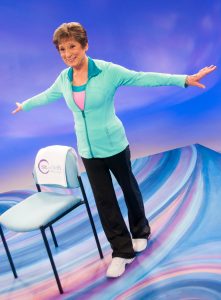
Improve Your Sensory System Through Exercise
By Mary Ann Wilson, RN
The body depends on many different systems working together to maintain good balance. The sensory, motor and central nervous system all play important roles in keeping us steady on our feet. What’s exciting to me is that there are specific exercises we can do to sharpen each of these pathways and systems.
Let’s take a look specifically at the sensory system which functions by collecting valuable information through three pathways:
1) the eyes (called the ocular or visual system)
2) the ears (called the vestibular system)
3) external sensory receptors from skin and internal proprioceptors from joints and muscles (called the somatosensory system)
Information collected through these receptive pathways is sent, via the central nervous system, to the motor system which in turn responds with appropriate movements needed to carry out activities such as walking. There is ample research demonstrating that through physical activity and exercise these three sensory systems can be worked effectively to help maintain and/or improve balance.
The Somatosensory System and Balance
Let’s take a closer look at how to work the somatosensory system through exercise. The somatosensory system uses pressure receptors and internal proprioceptors in the skin, muscles, ligaments and joints. These receptors tell us the position of our body, and where it is in space, without looking. We can challenge this system by trying to balance with eyes closed. By taking vision out of the equation somatosensory pathways are strengthened because they are being forced to work harder.
Another way to improve somatosensory function is to change the supporting surface, i.e. standing on a piece of foam. A less sturdy base challenges balance by forcing us to make adjustments in order to keep our center of gravity over our base of support. These type of exercises help improve our ability to adapt comfortably to changing surfaces and other environmental obstacles encountered in day to day life.
Balance Exercises to Practice Daily
Here’s an exercise that will help you become aware of your sense of touch and how it can help you maneuver your way in dim lighting such as a trip to the bathroom late at night.
Phase 1:
Begin this exercise in a seated position. Place your chair in the middle of a doorway and sit down. Close your eyes and notice any disorientation. Keep the eyes closed throughout this exercise. Touch the right hand to right side of doorway, then the left hand to left side. With both hands reach a little higher on the doorway, then a little lower. Repeat until you begin to feel more comfortable. Open eyes. Remove the chair and repeat the exercise standing.
Phase 2:
Start this exercise by standing along a counter, wall or couch back. with one hand lightly touching the surface (photo step #1). Avoid looking down at the ground throughout the exercise. Stand tall in good postural alignment and slowly walk in tandem (one foot in front of the other as if on a tightrope). Turn around and return to the starting position. When that becomes easy, try the same exercise with arms extended to the side (photo step #2). If you have good balance try walking backwards in the same way. To advance this exercise, practice the above with eyes closed. Have someone in the room with you to monitor your safety. If at any time you begin to lose your balance or feel dizzy open your eyes immediately.


Related Blogs:
Balance Exercises for Somatosensory System
Hamstring Strength For Better Balance
Balance Throughout the Day Exercises

I appreciate perusing your internet site. Thanks a lot!
very nice information. keep up the good work
very nice info
Very good workouts, love all the DVDs. However, as someone who suffers from PPPD (Persistent Postural-Perceptual Dizziness) I have to say that new spiral floor makes me dizzy – seems like you would have thought of that.